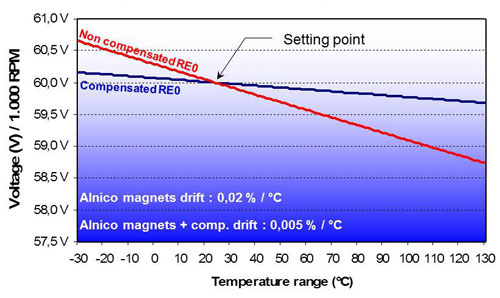Magnets
Tachogenerators with rare earth magnets, due to their higher energy compared to ALNICO-magnets, have a shorter time constant, assuring better performances in a closed loop process where a minimum lapse of response time is necessary.
Calibration precision
Tachogenerator manufactures normally apply a magnetic calibration of the magnets and can achieve a calibration precision for standard products of +/– 1% to +/- 2% depending on the manufacture and product model.
Linearity
The DC component of the output voltage is supposed to be proportional to the speed, but a bad contact of the brush on the commutator and the armature reaction due to the load are in general the reason for non-linearity. Some manufactures guarantee the linearity of its products for a large speed range.
Ripple rate
The ripple rate superposed to the DC voltage possesses a frequency spectrum which can be decomposed in terms of correlation : to the rotational speed, the number of poles, the number of armature slots, and the number of collector blades. The first and last element depends essentially on the quality of the mechanical construction of the machine and on a correct mounting (symmetry defect, eccentricity, etc…). The other elements are of electromagnetic origin and depend on the design of the product. The ripple is the medium peak value of the output signal, possibly filtered, compared to the DC value.
Reversibility
The reversibility is the difference between the two speed constants measured in both rotational directions. Any difference is mainly due to a bad positioning of the brushes. Manufactures try to ensure the best position of the brushes in their design, the position of brushes is not usually adjustable.
Disturbances due to the temperature
The output signal is influenced by the temperature: the E.M.F. decreases due to the loss of the reversible magnetization of the magnets. This drift is linked to the type of magnets used.
The tachogenerators that use ALNICO magnets have a drift inferior to 0,02%/°C, compared to those which use Samarium Cobalt magnets have a drift inferior to 0,05%/°C.
When compensated the drift is inferior to 0,01 %/°C.
Mechanical disturbances
According to which magnets are used, the performance is more or less influenced by the mounting or dismounting of the rotor. The use of Samarium Cobalt magnets excludes the risk of demagnetization.
Contact between brushes and commutator
The quality of the contact between brushes and commutator is very importance, since the contact conditions affect the signal’s quality. The voltage drop due to this contact is one of the important factors of the tachogenerator’s behavior.
Several parameters influence the quality of this contact.
The pressure of the brush
It is chosen in order to obtain the best contact between the brushes and the commutator, but the brush life depends on it too.
The choice of material
The brushes are either electro graphite or silver-graphite, and the commutators are made of copper, or rarely of silver. The use of a silver commutator decreases the voltage drop even in harsher environments or after a longer period of non-use. Manufactures can usually offer a range of industrial tachogenerators with silver commutators covering a large range of applications.
The quality of the commutator’s surface
and special care is used during the machining of the commutator in order to obtain the best geometry possible and a predetermined state of surface (roughness of the collector blades)
The patina which forms on the surface of the commutator
in most industrial applications the temperature, the hygrometry, and the composition of the surrounding atmosphere leads to the formation of a smooth patina, and the contact between the brushes and the commutator remains stable and induces only a slight wear of the collector, on tachogenerators the typical wear of the collector is inferior to 0,1 mm for the life-time of the brushes.
Life-time
The life-time of brushes is not, in general, a limiting factor for the use of a tachogenerator, It is the number of turns in a year that determine its life (for example: 2000 hours of functioning at 3000 rpm represents 36.107 revolutions per year). Therefore most tachogenerators that are manufactured have a life-time superior to 3.109 revolutions, which in the given example corresponds to more than 8 years.
